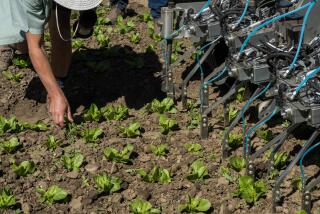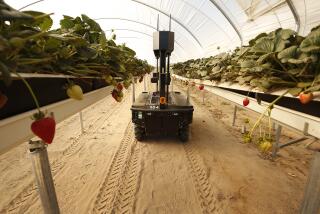Farmers Have Love-Hate Relationship With Biotech
ST. LOUIS — They’ve been burned by biotech yet are planting it still. And with enthusiasm.
American farmers are expected to plant more genetically engineered soybeans this spring than ever before--beans that will show up in processed foods from ice cream to salad dressing to veggie burgers. It should be a banner year for biotech cotton too, according to federal projections released Friday. And genetically modified corn will likely hold steady, accounting for about a quarter of the total U.S. corn crop.
This, despite growing public unease over tinkering with the food supply and tough international strictures against genetically engineered products. The issue heated up over the winter when StarLink, a type of biotech corn that had not been approved for human consumption, turned up in taco shells, corn dogs and scores of other foods--even in some bags of seed that had been advertised as the old-fashioned, conventional variety, free of genetic tinkering.
The ensuing uproar exposed how difficult it is to segregate genetically engineered crops.
Pollen drifts from one field to another. Stray biotech kernels stick to farm equipment and roll off into batches of non-engineered crops. Mix-ups happen at seed companies, in grain elevators, in processing mills. And it has proved to be impossible to catch every slip.
Tests routinely conducted on raw grain to determine biotech content “are intended to be risk-management tools,” explained Michael Russell of the testing firm GeneScan USA. “But to give you a foolproof answer? It can’t be done.”
Tainted Corn Sinks Deal
The uncertainty has cost some farmers big. Yet it has not diminished their excitement about a technology that lets scientists splice a gene from, say, soil bacteria into a soybean plant, giving the crop remarkable new properties.
Take Illinois grower Bernie Gordon. He lost $40,000 last year when his seed dealer warned him that his corn, which he had thought was biotech-free, could be contaminated with StarLink. Gordon had secured an excellent price for his crop, 30 cents a bushel above market rate, because it was not genetically altered. The StarLink scare sunk that deal. Even though his crop never tested positive for the contaminant, his $40,000 premium evaporated.
Gordon remains bitter about the loss. But not about biotech. He’ll be out there on his family farm later this spring, planting genetically altered beans.
It’s the same story at Alan Roebke’s farm in southwest Minnesota. Roebke is so irate about the StarLink mess that he’s sued the company that developed the seed. Though his crops were never found to be tainted, he alleges that unease over StarLink contamination was the reason corn prices dropped by 25%, devastating his income. “It just put an incredible black mark on American corn in general,” he fumed.
Yet this year, as last, all his soybeans and about a third of his corn will be biotech varieties. “We like them,” Roebke explains. “Very much.”
Genes Work, Invisibly
The biotech traits that so excite farmers are invisible to the public. The corn doesn’t look or taste any better; it’s been engineered to produce a natural insecticide that kills the dreaded European corn borer. The soybeans aren’t any more nutritious; they’ve been boosted with a gene that lets them stand up to a popular herbicide, so a farmer can spray his whole field at once and kill off the weeds while leaving the beans unscathed.
In certain regions of the country, the genetically engineered products have fast become indispensable.
The latest government projections indicate that 63% of this year’s soybean crop will be biotech--up from 54% last year. “We’ve been sold out of [biotech] beans since last December,” reports Jeff Lacina, a spokesman for the Garst Seed Co. He believes they’ll sell more biotech corn than last year too, though the government survey predicts a slight drop.
“This is such an amazing, such a super technology,” said Fred Yoder, who will be testing two types of biotech corn on his 1,000-acre farm in Ohio.
Transferring that enthusiasm to the consumer has proved tricky.
Surveys consistently show that American consumers are wary of genetically altered food; at least 75% want it labeled. Yet there is no consensus on what should trigger a label. Could a processed food be considered “non-biotech” if 5% of its ingredients were from gene enhanced crops? That’s the standard Japan now uses. The European Union takes a much stricter approach: If just 1% of any one ingredient is biotech, the whole food must be labeled “genetically modified.”
That debate is just heating up here.
But some critics of biotechnology wonder if it is already moot.
“The government has allowed this technology to become ubiquitous,” said Joseph Mendelson, legal director of the Center for Food Safety. “How will we ever get it out? It will be very difficult to purify.”
Indeed, nearly everyone agrees that total purity is not realistic. Just as the Food and Drug Administration allows two maggots per 100 grams of tomato sauce, or 1,250 insect fragments in 10 grams of oregano, so too will the government have to set standards for how much genetically altered material is acceptable in foods marketed as non-biotech.
“Zero tolerance is totally, unequivocally impossible in a scientific world,” Russell said.
That understood, farmers insist they’ll do their best to segregate biotech, since that’s what Europe and Japan demand and what the American consumer seems to want.
They have asked farm equipment designers for tools that are easier to clean, so biotech kernels won’t cling to them. They’re also working on developing a paper trail that could certify a product as non-biotech from the seed store to the grocery shelf.
“We need to earn respect back from the public. We need to show them we know how to handle these products,” said Yoder, the Ohio farmer.
He professes total faith in biotech crops. But he’ll spend an extra 20 minutes this spring ridding his planter of every last genetically altered seed before moving to a field of conventional corn. He’ll create a buffer zone around his biotech field, treating all the conventional crops along the perimeter as though they were biotech, just in case they’ve been contaminated.
“It’s a shame we have to do all this,” Yoder sighed. “But the customer is always right.”
More to Read
Inside the business of entertainment
The Wide Shot brings you news, analysis and insights on everything from streaming wars to production — and what it all means for the future.
You may occasionally receive promotional content from the Los Angeles Times.










